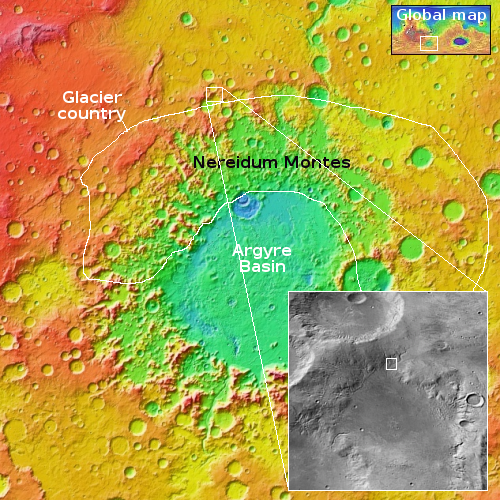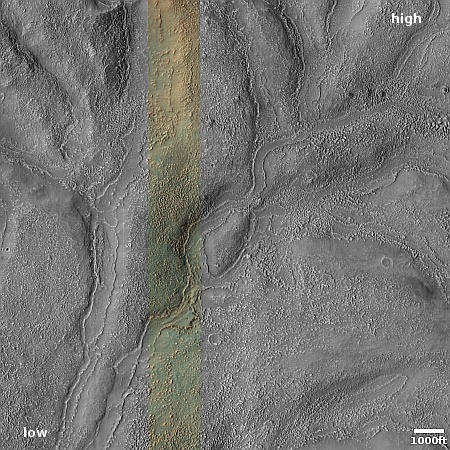Glacial tributaries draining south on Mars
Cool image time! The picture to the right, rotated, cropped, reduced, and sharpened to post here, was taken on March 27, 2024 by the high resolution camera on Mars Reconnaissance Orbiter (MRO). It shows what the scientists label as a “valley network”, what appears to be several tributaries flowing downhill from the northeast to come together into a larger single flow to the southwest. The elevation drop from the high to the low points in this picture is about 600 feet.
What formed the valleys? This location is at 35 degrees south latitude, so we are almost certainly looking at what appear to be shallow glaciers within those valleys, protected by a thin veneer of dust and debris. It also appears that the stippled surrounding plains might also contain a lot of near-surface ice, also protected by a thin layer of dust and debris. The stippling indicates some sublimation and erosion.

On the overview map to the right the rectangle just north of the the glacier country of the mountainous Nereidum Montes region marks this location. In the inset the small box indicates the area covered by the picture above.
The wide flat area that this flow appears to drain into might be an ancient and now very obscure crater, about 3000 feet lower than the surronding plateau. It also appears it might have once been a lake of ice or water. Its southwest rim appears cut by another valley network that served to drain this material further into the lower crater to the southwest.
When this happened cannot be determined from the data on hand. The surface features however suggest some very interesting and dynamic geological history involving a lot of water or ice.
On Christmas Eve 1968 three Americans became the first humans to visit another world. What they did to celebrate was unexpected and profound, and will be remembered throughout all human history. Genesis: the Story of Apollo 8, Robert Zimmerman's classic history of humanity's first journey to another world, tells that story, and it is now available as both an ebook and an audiobook, both with a foreword by Valerie Anders and a new introduction by Robert Zimmerman.
The print edition can be purchased at Amazon or from any other book seller. If you want an autographed copy the price is $60 for the hardback and $45 for the paperback, plus $8 shipping for each. Go here for purchasing details. The ebook is available everywhere for $5.99 (before discount) at amazon, or direct from my ebook publisher, ebookit. If you buy it from ebookit you don't support the big tech companies and the author gets a bigger cut much sooner.
The audiobook is also available at all these vendors, and is also free with a 30-day trial membership to Audible.
"Not simply about one mission, [Genesis] is also the history of America's quest for the moon... Zimmerman has done a masterful job of tying disparate events together into a solid account of one of America's greatest human triumphs."--San Antonio Express-News
Cool image time! The picture to the right, rotated, cropped, reduced, and sharpened to post here, was taken on March 27, 2024 by the high resolution camera on Mars Reconnaissance Orbiter (MRO). It shows what the scientists label as a “valley network”, what appears to be several tributaries flowing downhill from the northeast to come together into a larger single flow to the southwest. The elevation drop from the high to the low points in this picture is about 600 feet.
What formed the valleys? This location is at 35 degrees south latitude, so we are almost certainly looking at what appear to be shallow glaciers within those valleys, protected by a thin veneer of dust and debris. It also appears that the stippled surrounding plains might also contain a lot of near-surface ice, also protected by a thin layer of dust and debris. The stippling indicates some sublimation and erosion.

On the overview map to the right the rectangle just north of the the glacier country of the mountainous Nereidum Montes region marks this location. In the inset the small box indicates the area covered by the picture above.
The wide flat area that this flow appears to drain into might be an ancient and now very obscure crater, about 3000 feet lower than the surronding plateau. It also appears it might have once been a lake of ice or water. Its southwest rim appears cut by another valley network that served to drain this material further into the lower crater to the southwest.
When this happened cannot be determined from the data on hand. The surface features however suggest some very interesting and dynamic geological history involving a lot of water or ice.
On Christmas Eve 1968 three Americans became the first humans to visit another world. What they did to celebrate was unexpected and profound, and will be remembered throughout all human history. Genesis: the Story of Apollo 8, Robert Zimmerman's classic history of humanity's first journey to another world, tells that story, and it is now available as both an ebook and an audiobook, both with a foreword by Valerie Anders and a new introduction by Robert Zimmerman.
The print edition can be purchased at Amazon or from any other book seller. If you want an autographed copy the price is $60 for the hardback and $45 for the paperback, plus $8 shipping for each. Go here for purchasing details. The ebook is available everywhere for $5.99 (before discount) at amazon, or direct from my ebook publisher, ebookit. If you buy it from ebookit you don't support the big tech companies and the author gets a bigger cut much sooner.
The audiobook is also available at all these vendors, and is also free with a 30-day trial membership to Audible.
"Not simply about one mission, [Genesis] is also the history of America's quest for the moon... Zimmerman has done a masterful job of tying disparate events together into a solid account of one of America's greatest human triumphs."--San Antonio Express-News



A question is how many caves does Mars have- and how many are impassable because they are filled with H2O and/or CO2.
Also how many caves on the Moon? One could guess, not many are filled with H20 and/or CO2.
How many caves are under our ocean- they would mostly, filled seawater.
–How many caves are there on Earth?
The number of accessible caves on Earth is staggering. In the United States alone, at least 45000 have been identified, and the supposition is that there are thousands more. Worldwide, the number is almost certainly over a quarter million, and new caves are discovered on a nearly weekly basis.–
And some are found in the ocean, and ocean area is 70% of Earth surface.
gbaikie: Asking how many caves there are on Mars, or the Moon, or even the Earth, is like that standard question cave guides get all the time for tourists: “How many miles of unexplored passages are there in this cave?”
Do a search on BtB for “pits” and you will see a lot of posts about pits on Mars and the Moon. For the Moon look specifically for the caves in the crater Copernicus.
On Mars there should be plenty of lava tubes, created by flowing lava. Whether there are any caves formed by flowing water remains unknown.
It seems a hope of finding life on Mars, could be connected to finding a cave, which has water in it.
A cave with ice in it, could be good place for Mars exploration base, and perhaps a place for settlements on Mars.
Deep caves without anything filling them, should interesting in terms understanding the general geology of Mars.
But generally, I think mining a lot water, and making lake at the surface and having settlement around and within the lake seems
like good way to start to have settlements on Mars.
It’s a way of selling Mars real estate.